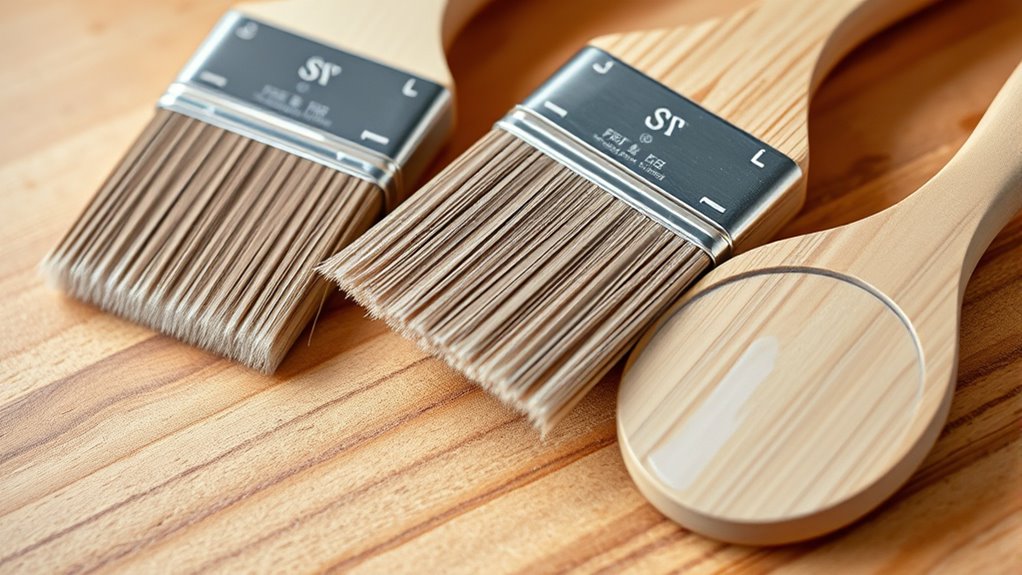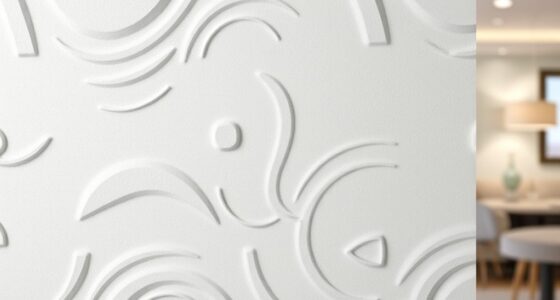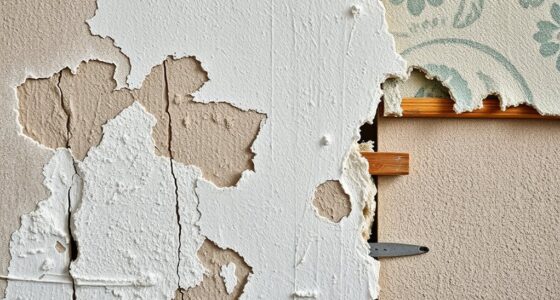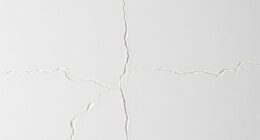For interior painting, you’ll want to choose from various brush types like angled brushes, which help with detailed edging and trimwork, and sash brushes, ideal for large surfaces and smooth coats. Smaller brushes with fine bristles are great for intricate areas, while foam brushes work well for touch-ups and varnishes. Selecting the right brush guarantees a clean, professional look, and exploring more options will help you find the perfect tools for your project.
Key Takeaways
- Angled brushes are ideal for detailed edging, trim work, and precise corners in interior painting.
- Sash brushes have wide, flat heads perfect for covering large wall surfaces efficiently.
- Smaller brushes with fine bristles are suited for detailed areas and intricate painting tasks.
- Foam brushes are useful for quick touch-ups and applying varnishes or sealers.
- Choosing the right shape and size enhances control, accuracy, and overall finish in your interior painting project.
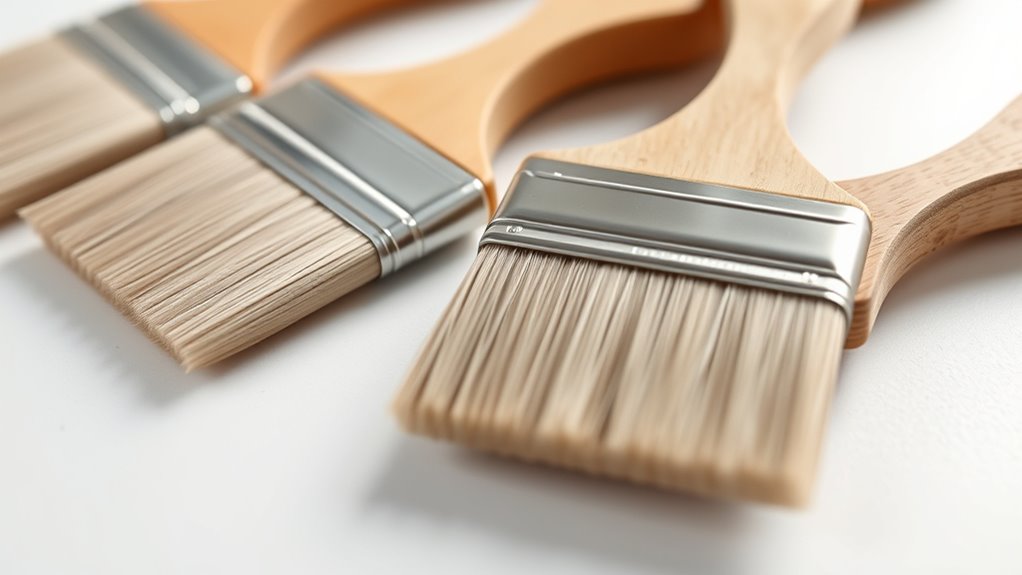
Choosing the right brush is essential for achieving a smooth, professional finish when painting indoors. The type of brush you select can substantially influence the quality of your work, especially when it comes to detail work or covering large surfaces. When exploring brush options, you’ll encounter various brush material options, each offering distinct advantages. Natural bristle brushes, typically made from hog hair, excel at applying oil-based paints and stains because their stiffness helps hold paint well and delivers a smooth finish. Synthetic brushes, often made from nylon or polyester, are better suited for water-based paints, offering flexibility, ease of cleaning, and better control. Some brushes combine both natural and synthetic fibers to optimize performance across different paints. It’s worth considering these options based on your specific project needs and the type of paint you’re using. Proper brush maintenance tips are also essential to prolong the life of your tools and ensure consistent results. After each use, thoroughly rinse brushes with the appropriate cleaner—water for latex paints and mineral spirits for oil-based paints. Reshape the bristles and store brushes flat or hanging to prevent damage. Regular cleaning prevents paint buildup, which can cause uneven application and reduce the brush’s lifespan. Additionally, understanding personal growth and wellness concepts can help maintain motivation and patience during your painting projects. When choosing among different brush types, consider the shape and size that best suit your task. For precise edging and trim work, an angled brush is invaluable. Its slanted bristles allow you to cut in neatly along corners and edges without drips or mess. If you’re working on larger, flat surfaces like walls or ceilings, a sash brush might be your best bet, offering a wide, flat head that covers more area efficiently. For detailed or intricate areas, smaller brushes with fine bristles provide control and accuracy. Foam brushes can also come in handy for quick touch-ups or applying varnishes, but they don’t hold as much paint and tend to wear out faster. Remember, the brush material and shape directly impact your painting outcome, so choose wisely. Keep in mind that investing in high-quality brushes, combined with proper brush maintenance tips, ensures you get a clean, even coat every time, reducing frustration and improving your overall project results. By understanding the different types and caring for your brushes properly, you set yourself up for a successful, professional-looking interior paint job.
Frequently Asked Questions
How Do I Choose the Right Brush for My Specific Project?
To pick the right brush, consider your paint application techniques and the surface you’re working on. For detailed work or tight corners, an angled brush works best. If you’re painting flat surfaces, a sash brush provides smooth coverage. Make sure your surface is properly prepared to avoid uneven strokes. Choose a brush size that matches your project’s scale, and always test it on a small area first to guarantee it suits your needs.
Are Synthetic Brushes Better Than Natural Bristle Brushes?
Imagine your brush gliding smoothly over walls like a whisper—synthetic brushes often outshine natural bristles here. They’re better for latex paints, more durable, and easier to clean, making them ideal for quick, long-lasting projects. Natural bristle brushes excel with oil paints but wear faster and require more care. So, if you want durability and versatility, synthetic brushes are your best bet, offering a reliable, professional finish every time.
How Do I Clean and Maintain Different Brush Types?
You should clean your brushes immediately after use with warm water and mild soap for water-based paints, or mineral spirits for oil-based paints. Use gentle cleaning techniques like swirling the brush in the solvent and reshaping the bristles. Store brushes properly by hanging them or laying them flat to prevent damage. Regularly inspect your brushes for wear, and clean them thoroughly to prolong their lifespan and maintain peak performance.
Can I Reuse Brushes for Multiple Colors?
Yes, you can reuse brushes for multiple colors, but you need to prevent color contamination and extend brush longevity. Rinse your brush thoroughly between colors, using water or paint thinner as appropriate. Shape the bristles and store it properly to maintain its performance. Taking these steps keeps your brushes in top condition, ensuring they remain effective, durable, and ready for continued use on future projects.
What Size Brush Is Ideal for Detailed Interior Work?
For detailed work, a small brush size, like a 1-inch or 1.5-inch, is ideal. These brushes give you precise control and help you navigate tight corners, intricate moldings, and delicate areas. Using a smaller brush allows you to focus on fine details without accidentally smudging nearby surfaces. Keep in mind, choosing the right size guarantees your work looks neat and professional, especially in those tricky, detailed spots.
Conclusion
Choosing the right paint brush is like picking the perfect tool for a craft—you’ll achieve a smoother, more professional finish. Whether you go for an angled brush for sharp edges or a sash for detail work, each type helps you master your interior painting project with confidence. Remember, the right brush can turn a simple wall into a masterpiece. So, pick wisely, and let your creativity flow like a brushstroke on a blank canvas.
